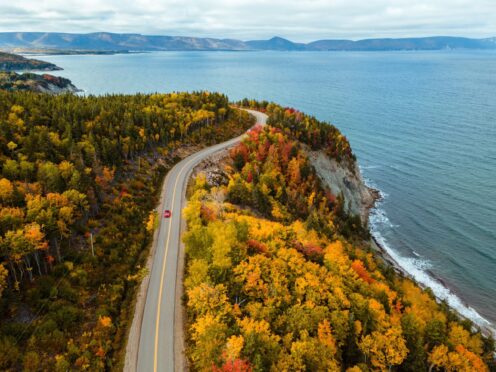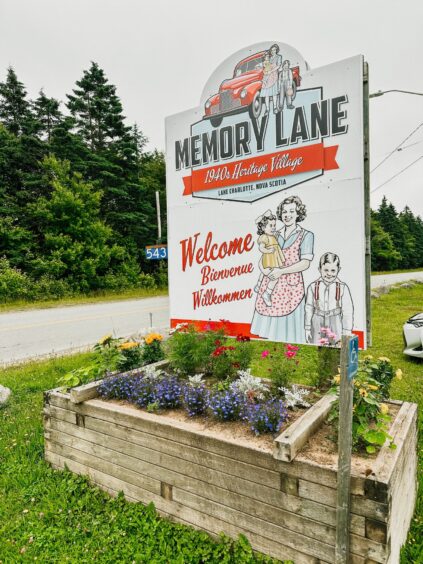
Driving along the scenic Marine Drive, an isolated two-lane road that hugs the winding coastline of Nova Scotia’s eastern shore in Canada, I came across a two-storey white clapboard home covered top to toe in carved wooden figurines painted the colours of the rainbow.
I had to stop.
But despite arriving unannounced, the owner, folk artist Barry Colpitt, welcomed me warmly and offered to show me around.
“Every carving is of someone that I know,” explained Barry, pointing out a figure of his third-grade teacher, the sculpted head of a woman from his church and his own self-portrait.
This impromptu and surprising visit was just one of many in a week-long trip that left me wondering why this corner of Canada was so unknown to outside visitors.
I had arrived in the provincial capital of Halifax several days earlier and spent a day exploring the city, touring the star-shaped stone citadel with a costumed guide and wandering the lively waterfront, filled with museums, shops and food kiosks doing a roaring trade in lobster rolls and poutine.
This was my second visit to Nova Scotia. Previously, I travelled along the province’s fabled south shore, home to candy-striped lighthouses and gelato-coloured fishing villages. This time, however, I planned to head east along a road less travelled.
My first stop after leaving Halifax was the Nalu Retreat & Nordic Spa, a set of three giant marshmallow-like geodomes perched on wooden platforms overlooking the dark blue waters of Porter’s Lake, one of the largest in the province. Despite being only 30 minutes from the capital, the location is wonderfully isolated.
It was tempting to spend all my time in the luxury dome soaking up the views, either from the panoramic window or from my private hot tub, but I couldn’t ignore my surroundings. I spent one morning hiking along the densely forested trails of nearby Crowbar Lake and an afternoon attempting to surf in the chilly waters of popular Lawrencetown Beach.
Another morning, I spent at the Acadian House Museum in the small community of Chezzetcook where a former family home reveals what life was like for the descendants of early French settlers.
One of the many joys of driving along the eastern shore is that distances are short and traffic non-existent and so it took less than an hour from Nalu Retreat to reach my next destination, Memory Lane Heritage Village.
This living history museum showcases rural life in Nova Scotia during the 1940s with 16 rescued and restored buildings typical of the decade.
With my guide, Rusty, I wandered through the one-room schoolhouse, stepped inside the church and ate a tasty lunch of beans made with molasses in the cookhouse. Most thrilling was my spin around “town” in the original cherry red 1948 International Pickup truck.
Thousands of islands pepper the eastern coastline, some are little more than rocky outcrops and others are larger with white sand beaches to rival the Caribbean.
Among these are the 100 Wild Islands, a protected archipelago that stretches for 30 kilometres along the rocky shoreline.
Near the town of Tangier, I met Gayle and Scott of Coastal Adventures who have been guiding visitors on kayaking trips for over 40 years. Together, we spent an afternoon paddling along the turquoise waters, past harbour seals sunning themselves on rocky outcrops and lion’s mane jellyfish floating in the impossibly clear waters.
“People just don’t know about this area,” said Gayle as we watched an osprey, fish clutched firmly in her talons, deliver lunch to her chicks in a nest perched high up a fir tree. “But it is just so beautiful and these islands are so special.”
Heading further east the road wound its way through dozens of small communities, once prosperous towns built on the fortunes of timber, shipping and gold.
One of the best places to understand the changing fortunes of this stretch of coastline is the Sherbrooke Village Museum that depicts life during the gold rush of the 1860s.
Unlike most historical museums where buildings are dismantled elsewhere and rebuilt on the museum site, the Sherbrooke Museum sits on the grounds of the original village and a handful of private homes remain within the museum boundaries.
Costumed interpreters bring the village to life, and I could have spent an entire day meeting the pharmacist in the drugstore, perusing the shelves of the Cuminger General Store and nosing around Greenwood House, the fanciest home in town.
My final stop was Guysborough, a small coastal town that, if it were located on the southern shore, would be packed with visitors enjoying its waterfront setting and charming heritage buildings.
“Overtourism is not something we have to worry about,” laughed Glynn Williams, owner of the Authentic Seacoast Company. Glynn is a Toronto businessman who fell in love with Guysborough in 1987 and has since invested millions in the town on numerous projects including a distillery and brewery that produces craft beers, vodka, whisky and award-winning rum.
He also owns Yurts In The Vineyard; a handful of Canadian-made authentic Mongolian yurts and I spent my final night in yurt No. 10 perched on a private peninsula overlooking the ocean.
As I watched the sun set – on both the day and my road trip – I reflected on a journey that delivered surprises around every corner and that, for the most part, I had all to myself.
Factfile
Air Canada flies from Edinburgh to Halifax via London Heathrow in a flight time of 10hr 50min. Flights from £386 return. Katja Gaskell was a guest of Tourism Nova Scotia. For more information, visit novascotia.com

Enjoy the convenience of having The Sunday Post delivered as a digital ePaper straight to your smartphone, tablet or computer.
Subscribe for only £5.49 a month and enjoy all the benefits of the printed paper as a digital replica.
Subscribe



